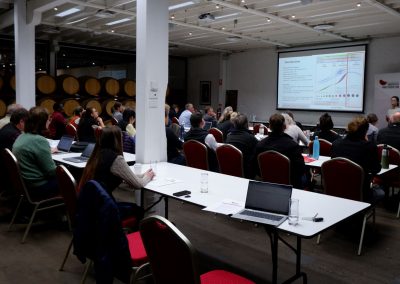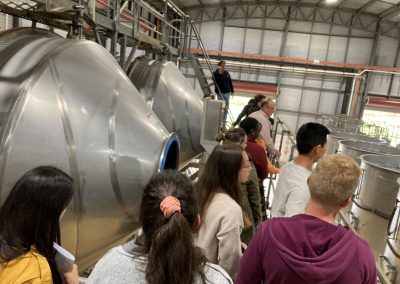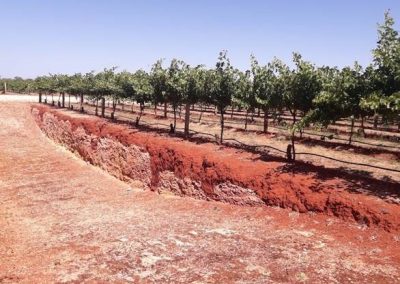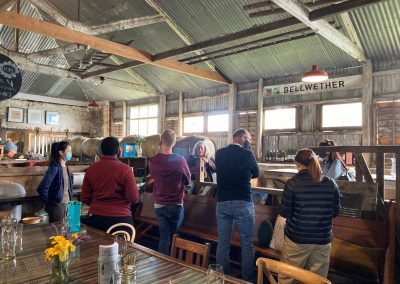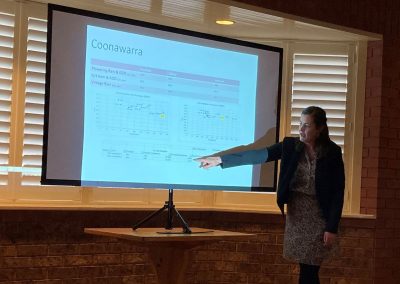By Yanina Giordano and Natalia Caliani
With a unique emphasis on innovation, world-class research training and the development of critical outputs for the wine industry, the Australian Research Council Training Centre for Innovative Wine Production (ARC TC IWP) offers its researchers workshop opportunities for networking, sharing research and receiving feedback from the Centre’s industry partners and the leading players from different Australian wine regions.
In mid-November 2021, Centre researchers were able to take part in an immersion trip to the Coonawarra wine region (South Australia). This magnificent tract of land is some of the most valuable agricultural area in the country. It is considered Australia’s greatest red wine area, producing high-quality grapes for some of the world’s finest wines. The limestone geology, the unique Terra Rossa soil and the cool climate found in this region are ideal for producing premium Cabernet Sauvignon and Shiraz with outstanding ageing potential. The objective of this field trip was to promote experiential learning and offer students stimulating learning experiences. These experiences provided personal contact with the wine industry, pointing out current industry needs, enabling active science communication, and integrating their research findings in the real world.
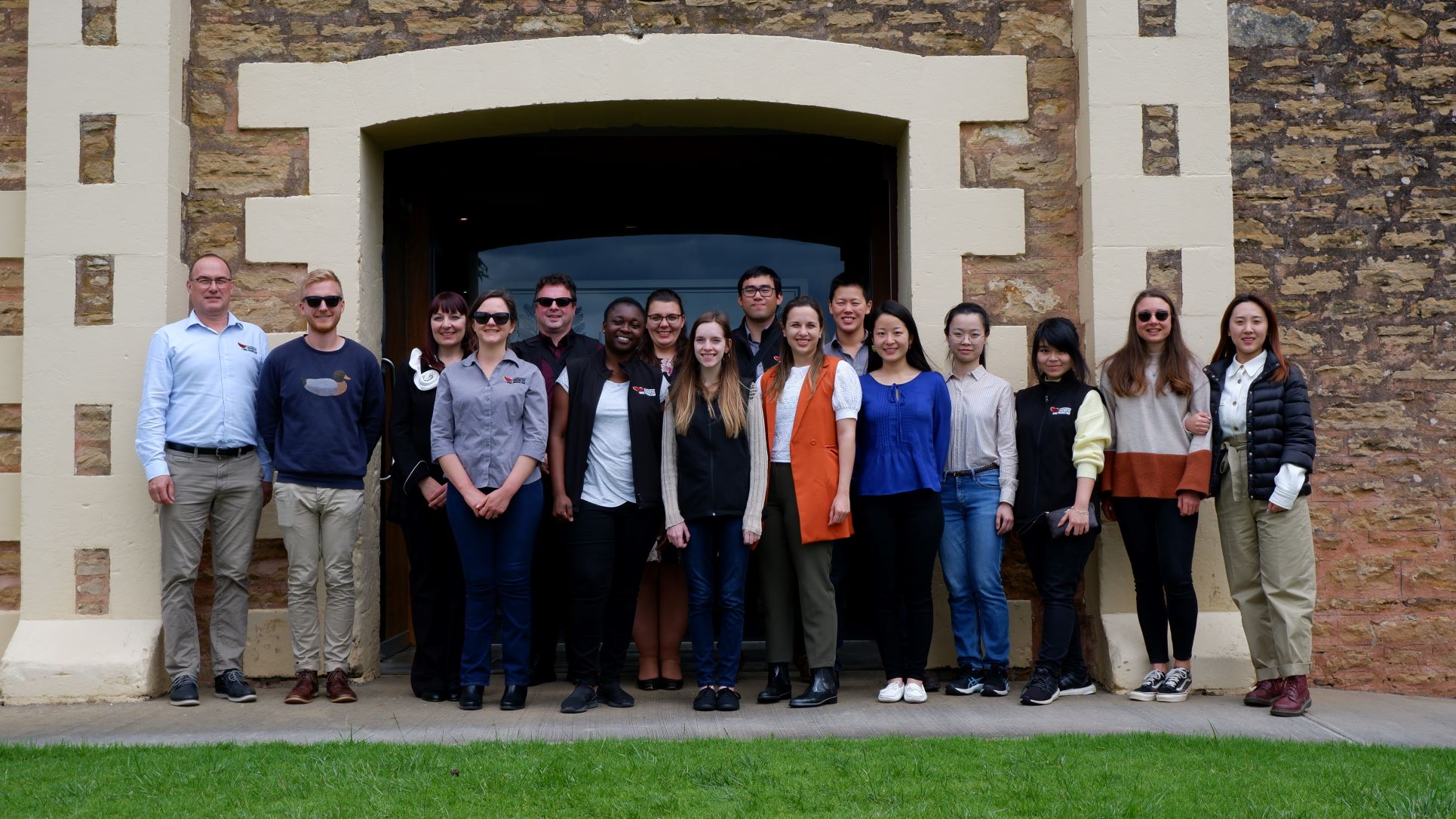
Centre members at Wynns Coonawarra Estate, November 2021. Photo: Y Sui.
In the picturesque charm of Wynns Coonawarra Estate, Centre researchers presented their latest research to industry partners, Coonawarra Vignerons and Winemakers. It is essential to highlight that three Centre projects are primarily focused on the Coonawarra wine region:
- Typicity of Coonawarra Cabernet. Dr Lira Souza Gonzaga and Dr Dimitra Capone, ARC TC IWP PhD student and post-doctoral researcher, respectively, are working on characterising Coonawarra Cabernet Sauvignon from a sensory and a chemical approach.
- Is it bad being different, understanding grape maturity in the Coonawarra. Claire Armstrong, ARC TC IWP PhD student, is working on managing grape heterogeneity to achieve high-quality red wines.
- Rootstocks, vine vigour and sunlight change the amount of methoxypyrazines in Cabernet Sauvignon rachis. Ross Sanders, University of Adelaide-CSIRO iPhD and ARC TC IWP student, is working on the effect of rootstocks on the production of methoxypyrazine in the rachis of Cabernet Sauvignon.
While in the Coonawarra we also visited leading growers and winemakers for on-site tours. Claire Armstrong introduced the group to Pete Balnaves, grower and owner of Balnaves of Coonawarra, where she has been conducting field trials. He described how he applies technology and information, such as Geographic Information System (GIS) and Normalised Difference Vegetation Index (NDVI), to manage his vines according to their site-specific necessities. The group were also shown soil pits across his vineyards which are used to appreciate different soil profiles within the same vineyard and manage them accordingly. One of these pits is in the famous Terra Rossa soil, a 26 km by 2 km strip of shallow but fertile red clay layer (hematite) on top of limestone.
The group also met Sue Bell, the owner of Bellwether wines. She is a winemaker with experience working for big and small companies in Australia, the USA and France. Bellwether, her wine playground, is where she works with special batches of fruit from small growers from different Australian wine regions. None of these batches are bigger than 1 tonne. Sue explained that all of her wine is made using uninoculated fermentation, which adds complexity to the texture and mouthfeel of these wines. It also means that the microflora (yeast and bacteria) present on the grapes expresses the uniqueness of every season. Apart from winemaking, Sue organises tasting and cooking events and hosts travellers in the winery campground. People can cook with herbs and veggies straight from the produce garden. This was an excellent example of running a diversified business, covering many different fronts.
The Centre’s researchers also met Dr Catherine Kidman, viticulturalist at Wynns Coonawarra Estate. Dr Kidman spoke with us over dinner and introduced her research as part of her role at Wynns. It was interesting to learn about their modelling of seasonal weather conditions and how this helps organise fungicide treatments, irrigation, and other viticultural practices.
The Coonawarra visit was an excellent opportunity to see a uniquely beautiful Australian wine region and meet its leading players. This interaction between research and industry was a fruitful experience. We received constructive feedback on our projects and discussed potential collaboration strategies. We also discovered a distinctive ‘terroir’ that produces full-bodied and, at the same time, delicate Cabernet Sauvignon and Shiraz wines.
As a result of the Coonawarra immersion workshop, we could exploit the Centre’s connections, expanding our own networks. We could also enjoy a unique opportunity for experiential, accelerated and deeper learning. Finally, this experience was a reciprocal exchange for the Centre students to see where their research projects will positively contribute to the wine industry globally.
ARC TC IWP would like to thank the following for their generous hospitality: Coonawarra Vignerons, Wynns Coonawarra Estate, Dr Catherine Kidman, Balnaves of Coonawarra and Bellwether Wines.
Yanina Giordano and Natalia Caliani are PhD students in the Australian Research Council Training Centre for Innovative Wine Production at The University of Adelaide.

